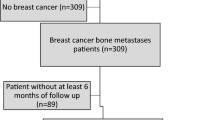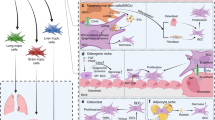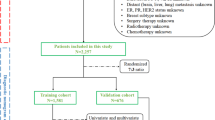Summary
Bone scintigraphy (BS) is commonly performed in the staging and postoperative monitoring of breast cancer. Nevertheless, due to low specificity it often demonstrates hot spots with equivocal interpretation, which may be misleading in the management of these patients. The aim of this study was to assess the value of a serum tumour marker panel in selecting among the patients with equivocal BS those with bone metastases. Between January 1986 and December 1995, 297 breast cancer patients were followed-up after mastectomy with serial determinations of a CEA-TPA-CA15.3 tumour marker panel, BS and liver echography. The tumour marker panel was used to select patients with equivocal BS for examination of suspicious bone areas by further imaging techniques. Up to December 1995, 158 (53%) patients showed an equivocal BS and 47 patients developed bone metastases. In the 158 patients with equivocal BS, prolonged clinical and imaging follow-up over 45 months (mean; range 12–120) was used to ascertain the presence or absence of bone metastases. In these 158 patients the negative predictive value and positive predictive value of the tumour marker panel to predict bone metastases was 97% and 75% respectively. This study shows that in breast cancer patients the CEA-TPA-CA15.3 tumour marker panel has a high value in selecting those patients with bone metastases, or at high risk of developing clinically-evident bone metastases, among the large number of subjects with equivocal BS.
Similar content being viewed by others
Article PDF
Change history
16 November 2011
This paper was modified 12 months after initial publication to switch to Creative Commons licence terms, as noted at publication
References
ASCO Tumor Marker Expert Panel (1996). Clinical practice guidelines for the use of tumor markers in breast and colorectal cancer. J Clin Oncol 14: 2843–2877.
Bonadonna, G. & Valagussa, P. (1993). Neoplasie della mammella. In Manuale di oncologia medica, Bonadonna G and Robustelli della Cuna G (eds), pp 529–563, Masson: Milano
Colman, L. K., Porter, B. A., Redmond, JIII, Olson, D. O., Stimac, G. K., Dunning, D. M. & Friedl, K. E. (1988). Early diagnosis of spinal metastases by CT and MR studies. J Comput Assist Tomogr 12: 423–426.
Cuschieri, A. (1973). Urinary hydroxyproline excretion in early and advanced breast cancer – a sequential study. Brit J Surg 60: 800–803.
Cuschieri, A. (1977). Urinary hydroxyproline in the management of breast cancer. World J Surg 1: 299–302.
Del Turco, M. R., Palli, D., Cariddi, A., Ciatto, S., Pacini, P. & Distante, V. (1994). Intensive diagnostic follow-up after treatment of primary breast cancer. A randomized trial. JAMA 271: 1593–1597.
Fateh-Moghadam, A. & Stieber, P. (1993). Use of tumour markers in certain solid tumours. In Sensible use of tumour markers, Fateh-Moghadam A, Stieber P (eds), pp 56–57, J Hartmann, Verlag GMBH: Munich
Fogelman, I. (1991). Bone scanning. In Clinical Nuclear Medicine, 2nd edn, Maisey MN, Britton KE and Gilday DL (eds), pp 131–157. Chapman and Hall Medical: London
Galasko, C. S. B. & Doyle, F. H. (1972). The detection of skeletal metastases from mammary carcinoma. A regional comparison between radiology and scintigraphy. Clin Radiol 23: 295–297.
Gielen, F., Dequeker, J., Drochmans, A., Wildiers, J. & Merlevede, M. (1976). Relevance of hydroxyproline excretion to bone metastasis in breast cancer. Br J Cancer 34: 279–285.
Guzzo, C. E., Pachas, W. N., Pinals, R. S. & Krant, M. J. (1969). Urinary hydroxyproline excretion in patients with cancer. Cancer 24: 382–387.
Held, P. & Breit, A. (1994). Comparison of CT and MRI methods in diagnosis of tumours of the para- and retropharingeal space and temporal bone. Bildgebung 6: 263–271.
Komaki, R., Donegan, W., Manoli, R. & Yeh, E. L. (1979). Prognostic value of pretreatment bone scans in breast carcinoma. AJR 132: 877–881.
Luthgens, M., Schelegel, G., Eklund, G. & Bjorklund, B. (1981). Correlation between activity in breast cancer and CEA, TPA and eighteen common laboratory procedures and the improvement by the combined use of CEA and TPA. Tumour Diagnostik 2: 6–11.
Meissner, W. & Warren, S. (1971). Neoplasms. In Pathology, 6th edn. Mosby: St. Louis
Moulopulos, L. A., Dimopoulos, M. A., Smith, T. L., Weber, D. M., Delasalle, K. B., Libshitz, H. I. & Alexanian, R. (1995). Prognostic significance of magnetic resonance imaging in patients with asymptomatic multiple myeloma. J Clin Oncol 13: 251–256.
Mundy, G. R., Ibbotson, K. J., D’Souza, S. M., Simpson, E. L., Jacobs, J. W. & Martin, T. J. (1984). The hypercalcemia of cancer-clinical implications and pathogenic mechanisms. N Engl J Med 310: 1718–1722.
Nicolini, A., Carpi, A., Di Marco, G., Giuliani, L., Giordani, R. & Palla, S. (1989). A rational postoperative follow-up with carcinoembryonic antigen, tissue polypeptide antigen and urinary hydroxyproline in breast cancer patients. Cancer 63: 2037–2046.
Nicolini, A., Colombini, C., Luciani, L., Carpi, A. & Giuliani, L. (1991). Evaluation of serum CA 15-3 determination with CEA and TPA in the post-operative follow-up of breast cancer patients. Br J Cancer 64: 154–158.
Nicolini, A., Carpi, A. & Tibaldi, C. (1992). The patients postoperative management of breast cancer patient: new concepts. In Progress in Clinical Oncology, Carpi A, Sagripanti A and Mittermayer CH (eds), pp 187–203. Sympomed Medical: Munchen
Nicolini, A., Anselmi, L., Michelassi, C. & Carpi, A. (1997). Prolonged survival by “early” salvage treatment of breast cancer patients: a retrospective six year study. Br J Cancer 76: 1106–1111.
Robinson, L. A. (1997). Radioisotope-guided surgical biopsy of suspected osseous metastases. Cancer Control 4: 517–522.
Sanal, S. M., Flickinger, F. W., Caudell, M. J. & Sherry, R. M. (1994). Detection of bone marrow involvement in breast cancer with magnetic resonance imaging. J Clin Oncol 12: 1415–1421.
Shreve, P. D., Grossman, H. B., Gross, M. D. & Wahl, R. L. (1996). Metastatic prostate cancer: initial findings of PET with 2-deoxy-2-(F-18) fluoro-D-glucose. Radiology 199: 751–756.
Touitou, Y., Proust, J., Klinger, E. & Nakache, J. P. (1985). Biological and pathological factors affecting plasma gamma-glutamyl transpeptidase and alkaline phosphatase activity in the elderly. Clin Chim Acta 146: 1–10.
Virgo, K. S. (1996). The costs of cancer patient follow-up post-treatment. In: ASCO Educational Book, pp 328–329, the American Society of Clinical Oncology: Place
White, D. R., Maloney, JJ III, Muss, H. B., Vance, R. P., Barnes, P., Howard, V., Rhyne, L. & Cowan, R. J. (1979). Serum alkaline phosphatase determination-value in the staging of advanced breast cancer. JAMA 242: 1147–1149.
Author information
Authors and Affiliations
Rights and permissions
From twelve months after its original publication, this work is licensed under the Creative Commons Attribution-NonCommercial-Share Alike 3.0 Unported License. To view a copy of this license, visit http://creativecommons.org/licenses/by-nc-sa/3.0/
About this article
Cite this article
Nicolini, A., Ferrari, P., Sagripanti, A. et al. The role of tumour markers in predicting skeletal metastases in breast cancer patients with equivocal bone scintigraphy. Br J Cancer 79, 1443–1447 (1999). https://doi.org/10.1038/sj.bjc.6690230
Received:
Revised:
Accepted:
Published:
Issue date:
DOI: https://doi.org/10.1038/sj.bjc.6690230
Keywords
This article is cited by
-
A suggested guiding panel of seromarkers for efficient discrimination between primary and secondary human hepatocarcinoma
Tumor Biology (2016)
-
Risk of metastasis among rib abnormalities on bone scans in breast cancer patients
Scientific Reports (2015)
-
18F-Fluoride PET/CT is highly effective for excluding bone metastases even in patients with equivocal bone scintigraphy
European Journal of Nuclear Medicine and Molecular Imaging (2012)
-
Could the serial determination of Ca15.3 serum improve the diagnostic accuracy of PET/CT? Results from small population with previous breast cancer
Annals of Nuclear Medicine (2011)
-
Surveillance après traitement de cancer du sein (hors mutation)
Oncologie (2009)



